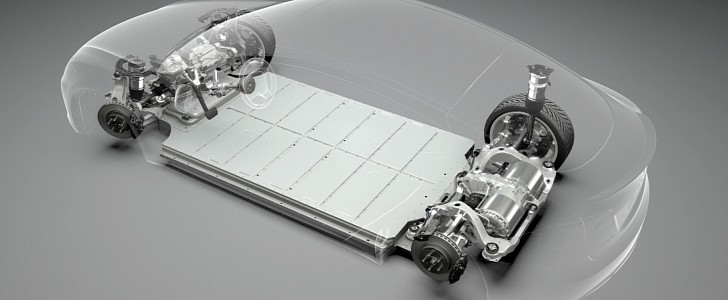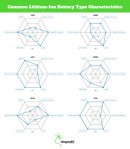When Tesla started deliveries of the Model 3 RWD with lithium ferrophosphate (LFP) batteries, it made a strange recommendation on its website and in the user manual. Unlike the usual charging behavior for Li-Ion batteries, Tesla said it’s OK to charge the battery to 100% and even recommends doing so as often as possible. But what was the reason behind this puzzling request?
Li-Ion batteries don’t like being charged above 90% (or even 80%), just as they don’t like being discharged close to zero. This has to do with the way they function and the chemical processes inside. For most Li-Ion batteries, the voltage increases or decreases almost linearly with the state of charge (SoC). This means a fully charged battery will have a higher voltage, while a depleted one will have a significantly lower voltage. For an NCA/NCM battery, the voltage varies between 4.2 volts and around 3.0 volts. Nevertheless, discharging them below 3.6 volts will accelerate the degradation process.
The problem is that a high state of charge will also impact the battery's lifecycle because common electrolytes are more stable at a lower state of charge. With the voltage increase, the electrolyte will start corroding the electrodes faster, thus shortening the battery’s life. According to Pedro Lima from PushEVs, this is why battery chemistries that favor lower voltages, like the LTO type (2.3 volts), have a longer lifespan. LFP batteries also have a lower voltage (3.2 volts) so their lifecycle is also longer than NCA/NMC types currently used by most EV makers, including Tesla.
So, based on this, charging a Li-Ion battery fully will shorten its lifecycle, no matter which chemistry it uses. This is true even for LFP batteries, although they have an increased durability thanks to their intrinsic lower voltage. But LFP batteries also have a peculiar characteristic that sets them apart from other chemistries. For instance, their voltage does not vary that much with the state of charge.
This is both good and bad. Good because they can stay at their nominal voltage (3.2 volts) most of the time. This helps with longevity, partly explaining why they last longer than other Li-Ion battery types. The voltage only rises above this level when they are almost full and drops when they are almost empty. Beyond that, the voltage curve is basically flat. This is bad for another reason, because the carmakers use the battery voltage to estimate its state of charge and consequently, the car’s range.
With little voltage variation comes imprecision in estimating the battery state of charge and car’s range, so you see how this can be a problem. You don’t like to see you have 30% of battery left and after a short drive to see this drop to 10% or even 5%. To improve this estimate (or guesstimate rather), the car’s battery management system (BMS) needs references, like a full charge point and a full discharge point. You see now why Tesla opted to sacrifice a little durability for increased precision in estimating a vehicle’s range.
So, the only reason Tesla recommends charging LFP batteries to 100% is to improve “the vehicle's ability to accurately determine the state of charge and estimated range,” as Tesla accurately says on its website. This does not help extend the battery’s life though. If you are concerned about that, you should always stick with the common recommendation to stop charging at a reasonable SoC, this often being 80%.
For an improved state of charge estimation, you should follow the recommendation to fully charge the battery once a week. This should be done before going on a trip, as you should avoid keeping the battery fully charged for extended periods.
Keep in mind that LFP batteries already have an improved lifecycle, so having them fully charged once in a while will not impact their lifecycle significantly. This is the main reason Tesla opted to compromise on this to offer a more accurate range prediction. After all, few people will complain that their car's battery did not last eight years or so, but there will be a litany of complaints if the range of the car would be unreliable.
The problem is that a high state of charge will also impact the battery's lifecycle because common electrolytes are more stable at a lower state of charge. With the voltage increase, the electrolyte will start corroding the electrodes faster, thus shortening the battery’s life. According to Pedro Lima from PushEVs, this is why battery chemistries that favor lower voltages, like the LTO type (2.3 volts), have a longer lifespan. LFP batteries also have a lower voltage (3.2 volts) so their lifecycle is also longer than NCA/NMC types currently used by most EV makers, including Tesla.
So, based on this, charging a Li-Ion battery fully will shorten its lifecycle, no matter which chemistry it uses. This is true even for LFP batteries, although they have an increased durability thanks to their intrinsic lower voltage. But LFP batteries also have a peculiar characteristic that sets them apart from other chemistries. For instance, their voltage does not vary that much with the state of charge.
This is both good and bad. Good because they can stay at their nominal voltage (3.2 volts) most of the time. This helps with longevity, partly explaining why they last longer than other Li-Ion battery types. The voltage only rises above this level when they are almost full and drops when they are almost empty. Beyond that, the voltage curve is basically flat. This is bad for another reason, because the carmakers use the battery voltage to estimate its state of charge and consequently, the car’s range.
With little voltage variation comes imprecision in estimating the battery state of charge and car’s range, so you see how this can be a problem. You don’t like to see you have 30% of battery left and after a short drive to see this drop to 10% or even 5%. To improve this estimate (or guesstimate rather), the car’s battery management system (BMS) needs references, like a full charge point and a full discharge point. You see now why Tesla opted to sacrifice a little durability for increased precision in estimating a vehicle’s range.
So, the only reason Tesla recommends charging LFP batteries to 100% is to improve “the vehicle's ability to accurately determine the state of charge and estimated range,” as Tesla accurately says on its website. This does not help extend the battery’s life though. If you are concerned about that, you should always stick with the common recommendation to stop charging at a reasonable SoC, this often being 80%.
For an improved state of charge estimation, you should follow the recommendation to fully charge the battery once a week. This should be done before going on a trip, as you should avoid keeping the battery fully charged for extended periods.
Keep in mind that LFP batteries already have an improved lifecycle, so having them fully charged once in a while will not impact their lifecycle significantly. This is the main reason Tesla opted to compromise on this to offer a more accurate range prediction. After all, few people will complain that their car's battery did not last eight years or so, but there will be a litany of complaints if the range of the car would be unreliable.









